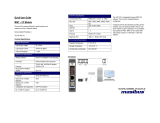
DeviceMaster UP Modbus/TCP User Guide: 2000447 Rev. I Table of Contents - iii
Table of Contents
Chapter 1. Introduction........................................................................................................7
1.1. Audience ................................................................................................................................................... 7
1.2. Comtrol Modbus Solutions................................................................................................................... 7
1.3. Product Overview .................................................................................................................................. 8
1.4. Modbus/TCP Firmware ......................................................................................................................... 8
1.4.1. Traditional Modbus/TCP System Architecture (Firmware V2.x) .................................................. 8
1.4.2. Enhanced Modbus/TCP System Architecture (Firmware 3.x) ....................................................... 9
1.4.3. Advanced Modbus System Architecture (Firmware 5.x) .............................................................. 10
1.4.4. Modbus/TCP Multi-Mode Connectivity ......................................................................................... 11
1.4.4.1. PLC Master/DeviceMaster UP Slave Mode ......................................................................... 11
1.4.4.2. PLC Slave/DeviceMaster UP Master Mode ......................................................................... 11
1.4.4.3. Dual Master (Virtual Peer-to-Peer) - Write Mode ............................................................... 12
1.4.4.4. Dual Master (Virtual Peer-to-Peer) - Read Mode (Dual Polling) ........................................ 12
1.4.4.5. Filtering and Data Extraction Functionality (Patent Pending) ......................................... 13
1.5. Definitions and Terms......................................................................................................................... 14
1.5.1. Data Type Definitions .................................................................................................................... 14
1.5.2. Glossary........................................................................................................................................... 14
1.6. Locating Updated Software and Documents ................................................................................. 15
1.7. Modbus/TCP Application Setup ........................................................................................................ 15
Chapter 2. Programming Interface..................................................................................17
2.1. Overview................................................................................................................................................. 17
2.1.1. Modbus Master Requirements ....................................................................................................... 17
2.1.2. What is Modbus/RTU?.................................................................................................................... 18
2.1.3. What is Modbus/ASCII? ................................................................................................................. 18
2.1.4. What is Modbus/TCP? .................................................................................................................... 19
2.2. Raw Data Interface .............................................................................................................................. 19
2.2.1. Supported Modbus Messages ......................................................................................................... 19
2.2.2. Serial Port Raw/ASCII Interface ................................................................................................... 20
2.2.3. Ethernet Device Raw/ASCII Interface .......................................................................................... 21
2.2.4. Raw/ASCII Transfer Modes ........................................................................................................... 21
2.2.4.1. Data-Stream Mode ................................................................................................................ 21
2.2.4.2. Command/Response Mode .................................................................................................... 22
2.2.5. Receive Data Message (Raw Data) ................................................................................................ 23
2.2.5.1. Format.................................................................................................................................... 23
2.2.5.2. Communication Methodology (Receive Raw Data in Slave Mode) ..................................... 24
2.2.5.3. Communication Methodology (Receive Data Master Mode) ............................................... 24
2.2.6. Transmit Data Message (Raw Data) ............................................................................................. 25
2.2.6.1. Format.................................................................................................................................... 25
2.2.6.2. Communication Methodology (Transmit Raw Data Slave Mode) ...................................... 26
2.2.6.3. Communication Methodology (Transmit Data Master Mode) ............................................ 26
2.2.7. Sequence Number Messages (Raw Data) ......................................................................................27
2.3. I/O Scanner (Raw Data) ...................................................................................................................... 27
2.4. Modbus/RTU and Modbus/ASCII To-Slaves Protocol Interface ................................................ 29
2.4.1. Communication Methodology......................................................................................................... 29
2.4.2. Modbus Slave Device Search Methodology ...................................................................................30
2.5. Retrieve Statistics Message ............................................................................................................... 31




















